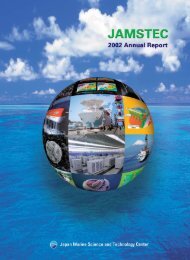2007 Annual Report - jamstec japan agency for marine-earth ...
2007 Annual Report - jamstec japan agency for marine-earth ...
2007 Annual Report - jamstec japan agency for marine-earth ...
Create successful ePaper yourself
Turn your PDF publications into a flip-book with our unique Google optimized e-Paper software.
the precipitation is simulated well Figu.6e.<br />
These results suggest that the change in the precipitation is<br />
more strongly controlled by the change in the long-term variation<br />
of large scale atmospheric circulation than by the change in<br />
daily variations of precipitation process.<br />
The PCS run can be also applied to future projections. The<br />
PCS run would reduce the uncertainty caused by the natural<br />
variability in the simulated climatic change and exclude model<br />
biases in the present climatology reproduced by each GCM.<br />
The PCS run would contribute to the reduction of the uncertainty<br />
of the downscaling method. The reproducibility of the climate<br />
change was confirmed by the PCS run in this study, which<br />
contributes to project the future regional climate.<br />
about 20km 20km-AGCM, precipitation is produced by the<br />
convective parameterization and large-scale condensation.<br />
To investigate degree of risk of hydrological disasters, the<br />
mean precipitation amount among three heavy precipitation<br />
events that ranked the highest every year P Top3 at each grid<br />
point was used as an index of extreme precipitation. Figure7<br />
shows distributions of P Top3 <strong>for</strong> the accumulation periods of 1, 6,<br />
and 48 hours with 20km-AGCM, 5km-NHM, and observation.<br />
The P Top3 <strong>for</strong> shorter accumulation periods is useful index in<br />
association with short-span heavy precipitation induced by<br />
cumulonimbus clouds. Steep mountains and densely populated<br />
areas enhance the significance of short-span heavy precipitation<br />
indices in Japan. The P Top3 <strong>for</strong> longer accumulation periods is<br />
associated with mesoscale precipitation systems and maximum<br />
flow <strong>for</strong> larger rivers.<br />
The P Top3 with 20km-AGCM and 5km-NHM were underestimated<br />
in comparison with the observation. However, P Top3<br />
with 5km-NHM was reproduced significantly better than that<br />
with 20km-AGCM, especially <strong>for</strong> the shorter accumulation<br />
periods. The difference of P Top3 <strong>for</strong> the longer accumulation<br />
periods between these models was small. For the estimation of<br />
extreme precipitation <strong>for</strong> shorter accumulation periods, nonhydrostatic<br />
model with finer resolution is considered to be<br />
Fig.6 Distributions of ten-year mean monthly precipitation unit:<br />
mm month-1 in June: a observations at the stations and c<br />
simulation by the Hindcast run in the 1990s. Differences in precipitation<br />
between the 1960s and the 1990s b observed at the stations, d<br />
simulated by the Hindcast run, and e simulated by the PCS run. In<br />
Figs. 6b, 6d, and 6e, blue red shading indicates that precipitation<br />
increased decreased from the 1960s to the 1990s. Kawase et al,<br />
2008 submitted to SOLA.<br />
required.<br />
One of the most noticeable and interesting changes in precipitation<br />
over the land areas of Japan projected by 5km-NHM<br />
was enhancement of precipitation in the mountainous areas<br />
along the Pacific coast of western Japan not shown. This<br />
enhancement is considered to result in incremental low-pressure<br />
induced by the enhancement of moist diabatic heating around<br />
c. Cloud/Precipitation Process Group<br />
Kyushu in which precipitation and updraft was originally large.<br />
c-1.Reproducibility evaluation of extreme precipitation in the<br />
Baiu season using a cloud-system-resolving model<br />
The reproducibility of extreme precipitation in the Baiu<br />
season around Japan was evaluated using a non-hydrostatic<br />
cloud-system-resolving regional atmospheric model with a horizontal<br />
grid size of 5km 5km-NHM. Precipitation is explicitly<br />
produced by cloud physics schemes with bulk parameterization.<br />
For the outer condition of 5km-NHM, which is an atmospheric<br />
general circulation model with a horizontal grid size of
















